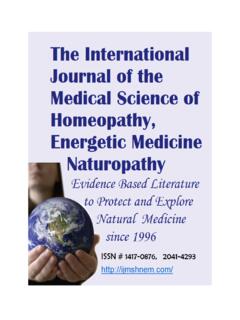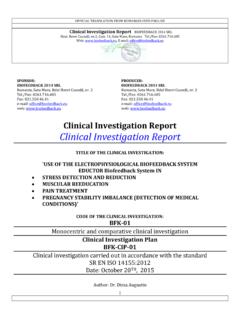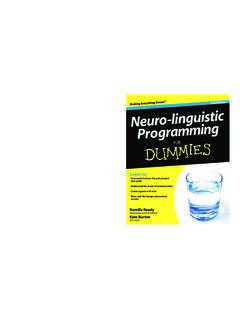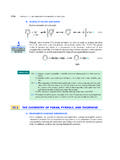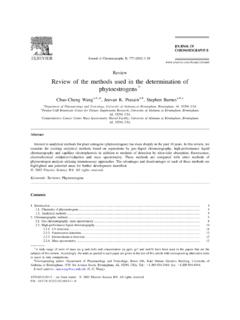Transcription of Are Humans Designed To Eat Meat Heme Iron from …
1 Heme Iron from Meat and Risk of Colorectal Cancer: A Meta-analysis and a Review of the Mechanisms Involved 1. Nadia M. Bastide, 2. Fabrice Pierre, and 3. Denis E. Corpet +Author Affiliations 1. Authors' Affiliation: Universit de Toulouse, INRA TOXALIM (Research Centre in Food Toxicology), INP ENVT, Toulouse, France 1. Corresponding Author: Fabrice Pierre, INRA; TOXALIM (Research Centre in Food Toxicology); Toulouse, France / Universit de Toulouse; INP; ENVT; 23 ch. Capelles, 31076 Toulouse, France Phone: 0561193289; Fax: 0561491263; E-mail: Next Section Abstract Red meat and processed meat intake is associated with a risk of colorectal cancer, a major cause of death in affluent countries. Epidemiological and experimental evidence supports the hypothesis that heme iron present in meat promotes colorectal cancer.
2 This meta-analysis of prospective cohort studies of colon cancer reporting heme intake included 566,607 individuals and 4,734 cases of colon cancer. The relative risk of colon cancer was (95% CI: ) for subjects in the highest category of heme iron intake compared with those in the lowest category. Epidemiological data thus show a suggestive association between dietary heme and risk of colon cancer. The analysis of experimental studies in rats with chemically-induced colon cancer showed that dietary hemoglobin and red meat consistently promote aberrant crypt foci, a putative precancer lesion. The mechanism is not known, but heme iron has a catalytic effect on (i) the endogenous formation of carcinogenic N-nitroso compounds and (ii) the formation of cytotoxic and genotoxic aldehydes by lipoperoxidation.
3 A review of evidence supporting these hypotheses suggests that both pathways are involved in heme iron toxicity. Cancer Prev Res; 4(2); 177 84. 2011 AACR. Previous SectionNext Section Introduction Cancer of the colon and rectum, taken together, are the third most common type of cancer worldwide (1). In most publications, colon and rectal cancer are studied together and the term colorectal cancer (CRC) is used, which we also use here, except when the publications refer specifically to colon or rectal cancer. CRC is the second most common cause of cancer death in affluent countries. Dietary modifications might reduce this cancer burden by up to 70% (2). Three recent meta-analyses showed that total meat intake is not related to risk but that intake of red or processed meat is associated with a modest, but significant risk of CRC (3 5).
4 Processed meat intake appears to be more closely linked with the risk of CRC than fresh red meat intake. In its 2007 report, the World Cancer Research Fund panel recommended that one should limit intake of red meat and avoid processed meat (1). Several mechanisms may explain the relationship between the risk of CRC and the intake of red or processed meat. First, meat cooked at high temperature contains mutagenic heterocyclic amines. But heterocyclic amines might not be major players in CRC risk, as: (i) consumption of chicken is a major contributor to intake of heterocyclic amines, but is not associated with the risk (6); and (ii) doses of heterocyclic amines that induce cancer in animals are 1,000 to 100,000 times higher than the dose ingested by Humans (7).
5 A second hypothesis suggests that the high saturated fat content of red and processed meat increases the risk of CRC. But several studies, including a recent meta-analysis, showed no effect of saturated fat on colorectal carcinogenesis (8 11). A third hypothesis concerns the carcinogenic N-nitroso compounds (NOC), which can be formed in the gastrointestinal tract by N-nitrosation of peptide derived amines or amides. The role of NOC in human cancer is discussed in the following text. Other more unlikely hypotheses involve the high protein, cholesterol, and salt content of red or processed meat. For a review of all these mechanisms, see ref. 12. Sesink and colleagues suggested that heme iron, in the form of hemin [chloroprotoporphyrin IX iron(III)] a ferric form of heme, may explain the link between the risk of colon cancer and red meat intake, and the lack of a link with white meat intake (13).
6 Epidemiological and experimental evidence support heme toxicity. Heme consists of an iron atom present at the center of a large heterocyclic organic ring called a porphyrin (Fig. 1). Heme is included in so-called hemoprotein, that is, hemoglobin, myoglobin (both involved in the oxygen supply), and in cytochromes (which catalyze electron transfer reactions). Red meat (such as beef, veal, lamb, mutton, pork, and offal) owes it dark red color to the presence of a high concentration of myoglobin, and the heme content of red meat is 10-fold higher than that of white meat (such as chicken; ref. 14). In processed red meat, heme iron is nitrosylated, because curing salt contains nitrate or nitrite (Fig.)
7 1; ). View larger version: In this page In a new window Download as PowerPoint Slide Figure 1. Structure of molecules cited in the review. The aims of the present mini-review were: (i) to conduct a meta-analysis of epidemiological cohort studies on heme intake and the risk of colon cancer; (ii) to review experimental evidence supporting the aforementioned heme hypothesis; and (iii) to understand the mechanism of action of heme in carcinogenesis. Heme iron intake and risk of colon cancer: a meta-analysis of prospective cohort studies The objective of this part of the review was to assess, through meta-analysis, the magnitude of the relation between heme iron intake and colon cancer. As most studies do not report data on rectal cancer, we decided to limit our analysis to colon cancer.
8 The methodological procedure is described in the Supplementary Material to this article. The characteristics of the 5 prospective cohort studies included in the meta-analysis are summarized in Supplementary Data (Table S1). This meta-analysis included data on 566,607 individuals and 4,734 cases of colon cancer. Although 1 cohort study found no association between heme and cancer (15), 3 found that a high intake of heme iron was linked with a higher risk of colon cancer (16 18), and 1 found a positive, but not significant, association between heme iron and colon cancer (19; Fig. 2). In the Lee and colleagues study, the relative risk (RR) for both proximal and distal colon was (95% CI: ).
9 In the Balder and colleagues study, the association was positive in the 2 genders combined (RR = , 95% CI: ; ref. 17). The summary RR of colon cancer in all 5 studies was (95% CI: ) for subjects in the highest category of heme iron intake compared with those in the lowest category (Fig. 2). This meta-analysis showed a consistent association between high intake of heme iron and increased risk of colon cancer. View larger version: In this page In a new window Download as PowerPoint Slide Figure 2. Relative risks of colon cancer in prospective cohort studies, comparing the highest with the lowest category of heme iron consumption. Studies are ordered by year of publication. Squares represent study-specific RR and the size of squares is proportional to the statistical weight that each contributed to the summary estimate of relative risk (percentage weight of each study: Lee et al.)
10 , 2004, proximal: ; Lee et al., 2004, distal: ; Larsson et al., 2005: 18%; Balder et al., 2006, women: ; Balder et al., 2006, men: ; Kabat et al., 2007, ; Cross et al., 2010: 32%). Horizontal lines represent 95% CI. The diamond represents the summary estimate of the relative risk of all studies included in the meta-analysis. Two studies out of 5 considered calcium in the adjustments for the RR (16 18), and showed the strongest association between heme iron and colon cancer. This makes sense, as calcium inhibits heme-induced cytotoxicity, colonic epithelial hyperproliferation, and promotion of chemically induced carcinogenesis in animal models (20 22). Two studies we excluded from the meta-analysis found similar results.
